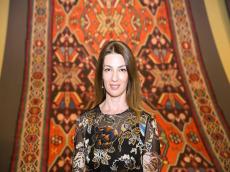|
|
TODAY.AZ / Arts & Entertainment
Azerbaijan's carpet weaving art promoted in Tatarstan
21 December 2021 [10:15] - TODAY.AZ

By Azernews
By Laman Ismayilova
Azerbaijan's carpet weaving art has been promoted in Tatarstan.
The National Carpet Museum director Shirin Malikova represented the country at the International Symposium "The Art of Weaving in the Turkic World: History and Modernity" held in Kazan.
She informed the symposium conference about the museum's actives. Shirin Malikova also touched upon the restoration of the pileless carpet weaving techniques.
According to their technical aspects, Azerbaijani carpets are classified as flat-woven (pileless) and knotted (pile).
The flat-woven carpets are linked to the earlier period of carpet weaving. There are several kinds of pileless carpets such as Shadda, Verni, Jejim, Zilli, Sumakh, Kilim and Palas.
Shadda is a flat weave carpet, made primarily in Nakhchivan, Agdam, Gubadly, Agjabadi. The artistic composition of shadda made by complicated whipping, as well as its constituents have a complex form.
One of the most widely spread types of the flat-weave carpet is "verni". The key pattern of "verni" is the S-element. Its shape varies, it may resemble both figure 5 and letter S. This element means "dragon" among the nomads and “water” among the village people. According to ancient beliefs, a dragon featuring carpet would protect the family from foul weather. Agjabadi, Barda, Aghdam, Nakhchivan are the centers of this type of pileless carpets.
Jejims are woven on simple horizontal looms by narrow stripes 30–35 cm wide and 15–10 cm long. The resulting product is a cloth to be used as a wall carpet, a bedding coverlet, or curtains.
The major jejim production centers are Barda, Nakhchivan, Zangilan, Shusha, Shamakha.
Zilli carpet is characterized by stylized forms of animals and vegetal elements. In terms of their composition and pattern the Azerbaijani zillis are very diverse. They feature images of large elements in the shape of big lozenges, paired horns, and various stylized elements.
The Sumakh carpets have become widely spread and recognized over the last few centuries. Since the 18th century, they have been made in the country's Guba and Gusar regions.
The Sumakh carpets feature the diverse stylized vegetal motifs, various geometrical elements such as large hexahedral, square, rhomboid medallions.
Kilim is the most widespread type of flat-woven carpets. They are made by passing the weft through the warp using the technique of compound interweaving. Kilim is characterized by a slot-like gap (opening) around the geometrical patterns.
The technique of kilim weaving predetermines the pattern shapes in the form of a lozenge, triangle, and trapezium. Images of animals, birds and humans are geometrized in kilims. Kilims of different regions are distinguished by their composition, pattern, and colors. In terms of their technical peculiarities, kilims can be classified into five major groups based on the area of production: Kazakh, Karabakh, Absheron, Shirvan and Tabriz kilims.
Palas is one of the widely spread flat-weave carpets. The palas weaving process consists in passing the weft through the warp by a simple technique.
The weavers decorate the palas by traditional patterns in the form of horizontal stripes commonly used throughout Azerbaijan. As a rule, the palas is not framed by a border.
URL: http://www.today.az/news/entertainment/213651.html
 Print version
Print version
Connect with us. Get latest news and updates.
See Also
- 12 August 2025 [17:16]
Institute of Archaeology and Anthropology publishes its first int'l periodical scientific journal - 12 August 2025 [16:41]
B-Boy Mahmood: Participants from over 20 countries to join first Baku Flow - 11 August 2025 [16:40]
Zeynal Khalil: Poet of heartfelt truth and enduring legacy - 10 August 2025 [11:35]
Azerbaijan marks 112th anniversary of people’s artist Kazim Kazimzade - 08 August 2025 [15:42]
Competition announced for State-Commissioned film projects for this year - 08 August 2025 [14:13]
Azerbaijan's national heritage presented in Turkmenistan - 08 August 2025 [13:36]
Garabagh University's scholar publishes monograph - 08 August 2025 [12:43]
ANAS granted full membership status by InterAcademy Partnership - 08 August 2025 [11:46]
Second stage of selection round underway within Children's Art Festival - 07 August 2025 [15:23]
Azerbaijan National Library pays tribute to People's Writer Elchin Afandiyev
Most Popular
 Iran rejects planned transit corridor outlined in Azerbaijan-Armenia pact
Iran rejects planned transit corridor outlined in Azerbaijan-Armenia pact
 India’s Russian oil lifeline under threat as Trump turns up heat
India’s Russian oil lifeline under threat as Trump turns up heat
 Serbia hails U.S.-brokered Azerbaijan–Armenia peace declaration
Serbia hails U.S.-brokered Azerbaijan–Armenia peace declaration
 Witkoff said to meet Qatari PM to discuss Gaza peace
Witkoff said to meet Qatari PM to discuss Gaza peace
 Armenian PM, Erdo?an discuss Washington agreements and regional cooperation in phone call
Armenian PM, Erdo?an discuss Washington agreements and regional cooperation in phone call
 Ministry of Emergency Situations continues fire safety awareness in liberated territories
Ministry of Emergency Situations continues fire safety awareness in liberated territories
 Nigerian troops ambush armed gang in northwest
Nigerian troops ambush armed gang in northwest
